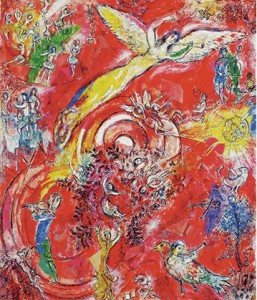CULTURE Chagall, When Color is Everything
Two events organized during the international Jewish festival in Milan, Jewish and the City, have introduced it and now, a short time after the official opening, it is clear that “Marc Chagall, a Retrospective 1908 – 1985” is an amazing exhibition. It will be open until the first of February 2015 at Palazzo Reale, and it brings together more than two hundreds works of the Belarusian-born French artist, coming from internationally renowned museums such as the MoMA and the Metropolitan Museum in New York, the National Gallery in Washington DC, the of Russian National Museum in St. Petersburg, the Pompidou in Paris and from more than fifty collections around the world.
The retrospective is organized in chronological order and exhibits masterpieces and works very rarely seen by Chagall from 1908 – the date of his earliest work – until the last, monumental paintings of the eighties: from the beginnings in Russia, the first stay in France and back in Russia, where he remained until 1921; the second exile in France, the escape from the Nazis in the United States, and the final return in Cote d’Azur, France. The works show the unique style of Chagall, characterized by the fusion of the three cultures to which he belonged: born in Vitebsk in a Lithuanian Jewish family (Belarus at that time was part of the Russian Empire), his name was Moishe Shagal, changed it to Marc Chagall when he moved to Paris in 1910, after studying art in St. Petersburg. Like his life, his art is deeply rooted in Jewish culture, from which he drew inspiration and into Russia, with its religious icons and the lubki (the popular prints that used to tell stories and to give news as sort of cartoons without words) and in the great tradition of the European avant-garde painters with whom he spent so much time in Paris.
During Jewish and the City the dialogue among Meret Meyer, Vice-President of the Chagall Committee e co-curator with Susanna Zevi of the biggest retrospective ever organized in Italy, Marcello Massenzio, university professor and author of “La passione secondo l’Ebreo errante” and Daniel Sibony, philosopher and psychoanalyst who has written various texts on the origins of artistic creation has attracted a big public and, moderated by the gallerist Jean Blanchart, has shown how much interest Chagall is always able to attract.
The closing concert of the festival – the evening before the opening of the exhibition – was dedicated to the Russian artist, who wrote that: “Color is everything. When color is appropriate, than shape is correct. Color is in every thing, it is a vibration, like music. Everything is vibration” to pay homage to one of the most iconic and mysterious figures of Chagall, the violinist. A musical performance with seven violins playing in the square in front of the Palazzo Reale, with music and words inspired by the work of Russian master. The narrator read excerpts from a diary in which Chagall talks about his own relationship with music and his grandfather’s violin outlining a fresco of life in the shtetl where he spent his childhood and where his imaginary world started to take shape.
The violinist, a central figure who accompanied the serious and the festive moments of the Hasidic community, well embodies the very idea of life and art of Chagall: the wondering Jew.
In addition to being recognized as the biggest and most representative Jewish artist of the Twentieth century, Chagall is also considered a fundamental exponent of some of the major European cultural movements: in his work he summarized cubism, symbolism and fauvism, and he got into surrealism as well. Best known for his paintings, with multiple colors, dreamy, enchanted atmosphere, populated by animals that fly, embracing lovers and violinists, he has also created tapestries, ceramics, glass windows and book illustrations.
The catalogue that accompanies the exhibition is to be considered among the largest and most comprehensive publications dedicated to the master: divided into eight sections corresponding to the different periods of the artist life and to the dominant themes in each of these periods, the volume is introduced by an extraordinary unpublished text, recently discovered in the Chagall archives in Paris, composed by several sheets of typewritten notes dictated in Russian by the same Chagall and studied by Tamara Karandasheva, thus creating a sort of completion of his famous youth autobiography, written in 1922.
The retrospective at the Royal Palace is accompanied by the exhibition “Chagall and the Bible”, held at the Diocesan Museum of Milan until February 1, 2015: it gathers 60 works and 22 preparatory gouaches recently discovered and exhibited for the first time. They are all and dedicated to themes and stories from the Torah, the Bible, considered by Chagall an essential source of art and poetry.

